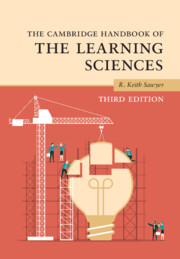Book contents
- The Cambridge Handbook of the Learning Sciences
- The Cambridge Handbook of the Learning Sciences
- Copyright page
- Contents
- Figures
- Tables
- Contributors
- Preface
- 1 An Introduction to the Learning Sciences
- Part I Foundations
- Part II Methodologies
- Part III Grounding Technology in the Learning Sciences
- 14 Video Games and Learning
- 15 Embodiment and Embodied Design
- 16 Tangible and Full-Body Interfaces in Learning
- 17 Augmented Reality in the Learning Sciences
- 18 Mobile Learning
- Part IV Learning Together
- Part V Learning Disciplinary Knowledge
- Part VI Moving Learning Sciences Research into the Classroom
- Index
- References
18 - Mobile Learning
from Part III - Grounding Technology in the Learning Sciences
Published online by Cambridge University Press: 14 March 2022
- The Cambridge Handbook of the Learning Sciences
- The Cambridge Handbook of the Learning Sciences
- Copyright page
- Contents
- Figures
- Tables
- Contributors
- Preface
- 1 An Introduction to the Learning Sciences
- Part I Foundations
- Part II Methodologies
- Part III Grounding Technology in the Learning Sciences
- 14 Video Games and Learning
- 15 Embodiment and Embodied Design
- 16 Tangible and Full-Body Interfaces in Learning
- 17 Augmented Reality in the Learning Sciences
- 18 Mobile Learning
- Part IV Learning Together
- Part V Learning Disciplinary Knowledge
- Part VI Moving Learning Sciences Research into the Classroom
- Index
- References
Summary
Mobile learning is learning across multiple contexts using smartphones and tablets, digital watches and fitness bands, wearable tags, and other more specialized devices. In educational applications, these devices are often linked together through the Internet or Bluetooth wireless technology, supporting collaboration and interaction. Mobile devices support seamless learning by extending learning beyond the classroom into everyday real-world experience. Mobile devices support the blending of the “formal learning” of the classroom with “informal learning” that takes place at home, in museums, or with peers. Mobile devices support personalized learning, and yet when networked together they can at the same time support collaboration and group learning. Many mobile devices generate large volumes of data from each student’s device, supporting learning analytics applications.
Keywords
- Type
- Chapter
- Information
- The Cambridge Handbook of the Learning Sciences , pp. 362 - 382Publisher: Cambridge University PressPrint publication year: 2022



